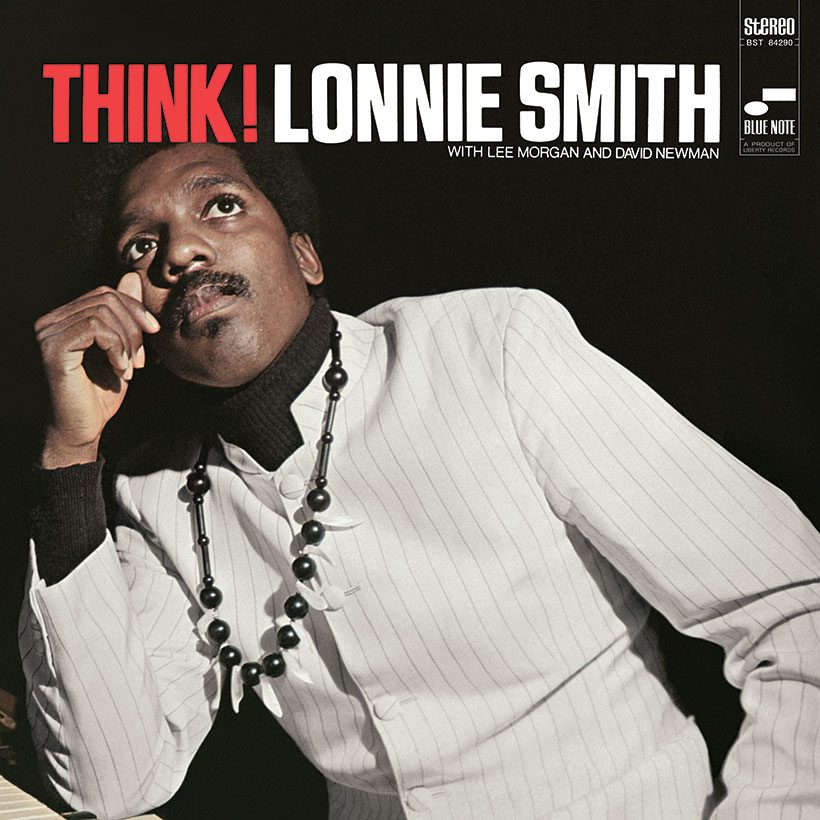‘Think!’: How Lonnie Smith Became The Hero Of The Hammond
With his debut Blue Note album, he established himself as one of the rising new stars of organ-driven soul-jazz.

Though the well-known Jimmy Smith is often regarded as the pre-eminent Hammond B3 specialist in the jazz world, two other Smiths (both unrelated) also made their mark in the same era, playing soulful organ licks over a funkafied backbeat. There was Johnny “Hammond” Smith – who changed his name to Johnny Hammond to avoid being confused with a guitarist of the same name – and Lonnie Smith. The youngest of the three, Lonnie Smith (born in Lackawanna, New York, on July 3, 1942) made his debut for Columbia Records in 1967 when he was still a sideman for guitarist George Benson. Subsequently impressing Blue Note’s producer Alfred Lion through his work with alto saxophonist Lou Donaldson, Smith defected, releasing this Blue Note album, Think!, in 1969.
Recorded at Rudy Van Gelder’s famous Englewood Cliffs studio on July 23, 1968, Think! was a sizzling platter of piquant soul-jazz grooves. Thanks to Jimmy Smith, organ trios had been popular in the late 50s, but producer Alfred Lion decided to feature Lonnie Smith’s talent in a larger setting. He brought in trumpeter Lee Morgan, who had been Blue Note’s horn-playing boy wonder in the 50s, and now, at 30, was still at the top of his game, along with saxophonist and flutist David “Fathead” Newman (a long-serving member of Ray Charles’ band), together with guitarist Melvin Sparks and drummer Marion Booker, Jr (both of whom had featured on Smith’s Columbia album, Finger Lickin’ Good Soul Organ). On two tracks, the quintet was expanded to an octet with the addition of percussionists Henry “Pucho” Brown, Willie Bivins, and Norberto Apellaniz.
High-octane grooves
Think!’s opener, “Son Of Ice Bag,” is a vibrant cover of a 1967 US hit single on Uni Records by South African trumpeter Hugh Masekela. The track is driven by Booker’s kinetic drums, and, after the horns state the harmonized main theme over a descending chord sequence, guitarist Melvin Sparks takes a solo that is sparse but eloquent. He’s followed by Newman’s roving sax, and then Lee Morgan, whose solo exhibits a more extrovert character. After a reprise of the main theme, Lonnie Smith finally gets his chance with an extended spell in the spotlight. His solo almost begins tentatively, but gradually he ratchets up the excitement with a series of soulful motifs and fleet-fingered keyboard gymnastics.
The laidback elegance that defines “Son Of Ice Bag” is replaced by a pulsating, Latin-tinged Smith-penned tune titled “Call Of The Wild,” featuring a trio of busy percussionists. It begins, though, with a slow, dreamy intro, where for two minutes Newman’s pastoral flute, Morgan’s muted horn, and soft guitar shimmers from Sparks blissfully entwine. Then comes a thunderstorm of drums and percussion announcing a high-octane Latin groove that eventually leads to a thrilling trumpet solo from Lee Morgan.
“Think” is Smith’s organ-soaked take on soul queen Aretha Franklin’s 1967 hit for Atlantic Records. The track was also issued as a single for Blue Note, with “Son Of Ice Bag” on the flipside.
An auspicious release
Lonnie Smith’s take on the traditional children’s nursery rhyme “Three Blind Mice” takes its cue from Art Blakey & The Jazz Messengers’ 1962 jazz version, with its infectious harmonized horn melody. After the main theme, it breaks out into a sprightly, loose-limbed soul-jazz groove featuring solos from all the main protagonists.
Think! plays out with “Slouchin’,” a nonchalant, mid-paced groove peppered with Latin percussion. Sparks takes the first solo, followed by Morgan, who’s more meditative on this track. Then comes Newman with an athletic passage of strident tenor blowing before Lonnie Smith finds himself in the hot seat (though his contribution is deft and super-cool).
Released in early 1969, Think! rose to No.46 in Billboard’s list of the bestselling American R&B albums during a four-week stay in the chart. Despite the album’s success, it wasn’t the organist’s most commercially successful Blue Note release (its follow-up, 1970’s Move Your Hand, did even better, rising to No.24 on the same chart), but it was nevertheless an auspicious release and announced 26-year-old Lonnie Smith as a new hero of the Hammond B3 organ.












